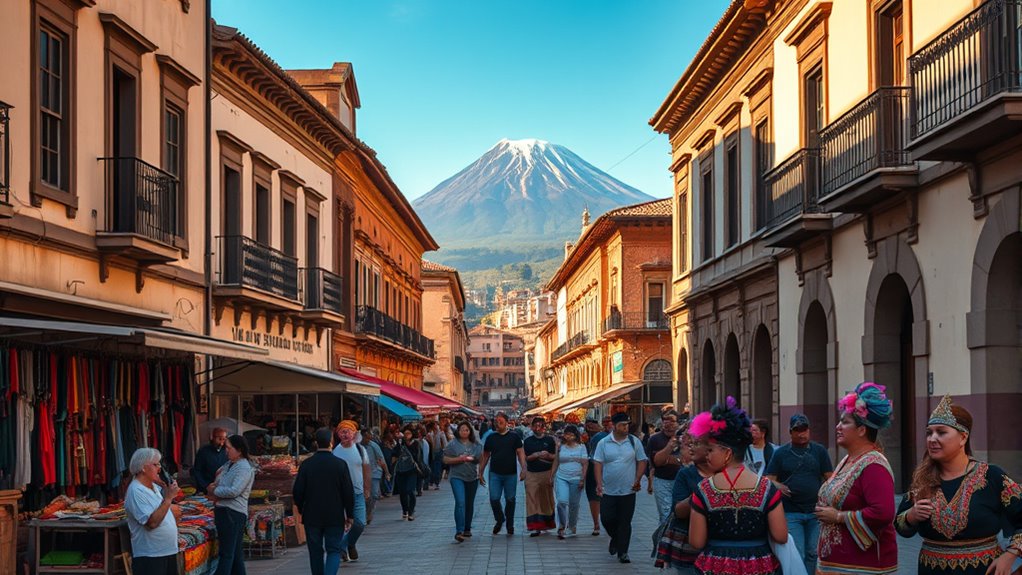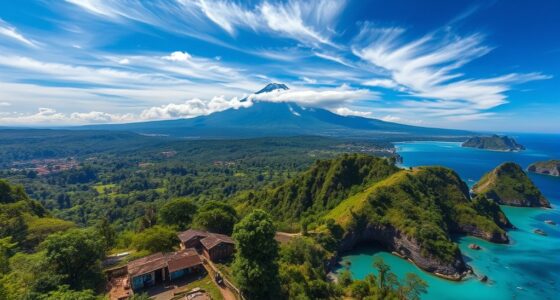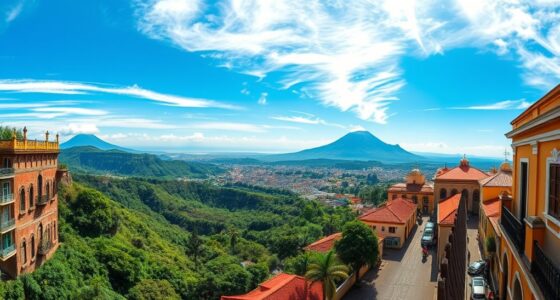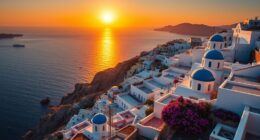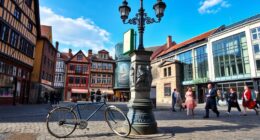Ecuador’s history and culture are shaped by its indigenous civilizations, colonial blend, and independence struggles. You’ll find remnants of the sophisticated Inca and pre-Inca societies through archaeological sites and vibrant traditions. Colonial influence shines in architecture and festivals, while modern movements preserve indigenous customs and promote social change. From lively celebrations like Carnival to diverse regional cuisines, Ecuador’s cultural richness is remarkable. Keep exploring further to uncover even deeper stories behind this vibrant nation’s heritage.
Key Takeaways
- Ecuador’s history is shaped by indigenous civilizations, Spanish colonization, and independence movements, forming a diverse cultural heritage.
- Pre-Columbian sites like Cochasquí demonstrate advanced engineering and spiritual practices of ancient indigenous societies.
- Colonial influence blends indigenous traditions with Spanish architecture, Catholicism, and festivals, creating a unique cultural synthesis.
- Modern Ecuadorian culture features vibrant festivals, indigenous crafts, and contemporary art that honor historical roots and cultural resilience.
- Social movements and regional diversity continue to influence Ecuador’s evolving political landscape and cultural expressions today.
Pre-Colonial Indigenous Heritage
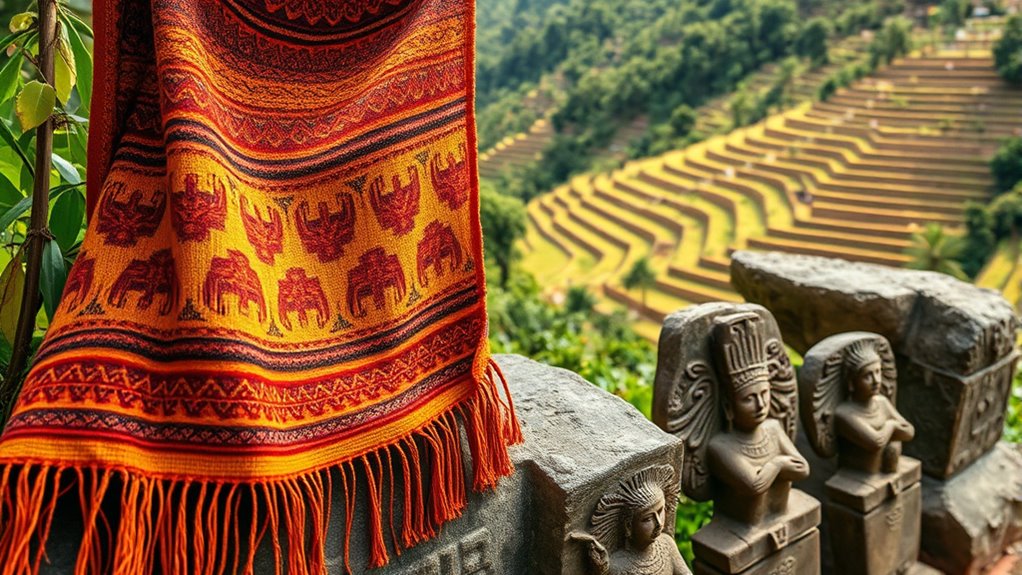
Have you ever wondered how Ecuador’s rich indigenous heritage shapes its identity today? You can see it in the vibrant traditions, languages, and art that persist across the country. Indigenous cultures like the Inca and other pre-Inca civilizations built sophisticated societies long before the Spanish arrived. Archaeological sites such as Cochasquí and Cuello de Luna reveal their advanced engineering and spiritual practices. Indigenous communities developed innovative agricultural techniques, cultivating crops like potatoes and maize, which remain staples today. Ethnic diversity thrived, with each group maintaining unique customs, rituals, and crafts. This heritage isn’t just history; it’s woven into Ecuador’s modern identity, influencing everything from cuisine to festivals, and serving as a reminder of the resilience and richness of its indigenous roots. Additionally, Archaeological sites showcase the enduring legacy of these ancient societies and their contributions to cultural development.
Colonial Foundations and Cultural Synthesis

The colonial period in Ecuador laid the foundation for a unique cultural synthesis by blending indigenous traditions with Spanish influences. You’ll notice how indigenous art, music, and religious practices merged with Catholicism, creating a vibrant cultural landscape. Spanish architecture, especially in cities like Quito, reflects colonial styles, with churches and plazas that still stand today. You’ll see how indigenous communities retained their customs while adopting new religious and social practices introduced by the colonizers. This blending resulted in festivals, cuisine, and social norms that are distinctly Ecuadorian. You’ll also observe how the Catholic Church played a central role in shaping cultural life, influencing education, art, and community identity. Additionally, the incorporation of color symbolism into religious festivals exemplifies the deep integration of indigenous beliefs with Catholic practices. Overall, this period set the stage for Ecuador’s diverse and layered cultural identity.
Struggles for Independence and Nation-Building
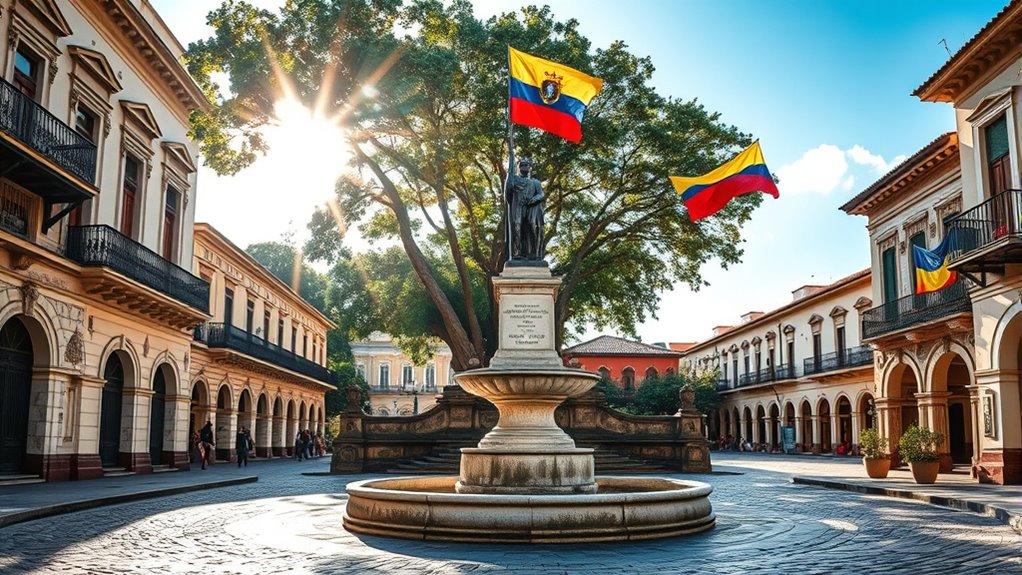
Building on Ecuador’s colonial foundations of cultural mixing, the push for independence emerged as a powerful movement driven by a desire to reclaim sovereignty. You join a wave of rebels inspired by Latin American independence ideas, rallying around leaders like José Joaquín de Olmedo. The Battle of Pichincha in 1822 was a turning point, securing victory against Spanish forces. Ecuador then joined Gran Colombia but seceded in 1830 to establish its own republic. To understand this process better, consider the following:
| Key Figures | Major Events | Outcomes |
|---|---|---|
| José Joaquín de Olmedo | Battle of Pichincha (1822) | Ecuador becomes independent |
| Antonio José de Sucre | Formation of Gran Colombia | Sovereignty asserted |
| Simón Bolívar | Separated from Gran Colombia | Establishment of Ecuadorian nation |
Furthermore, understanding the industry trends at the time helps contextualize the broader regional movements.
Modern Political and Social Developments
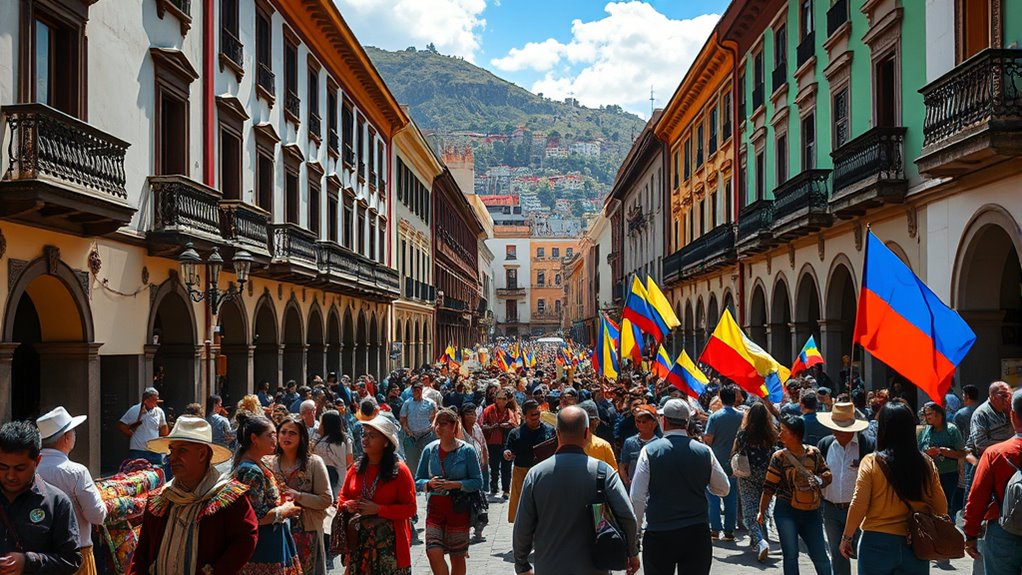
Modern political and social developments in Ecuador have shaped its current landscape, reflecting a nation that continues to evolve from its tumultuous past. You witness a country striving for stability, democracy, and social justice. Recent years saw efforts to combat corruption, improve governance, and expand social programs. Ecuador’s political scene is marked by transformations, including constitutional reforms and leadership changes. Social movements now champion indigenous rights, gender equality, and environmental conservation. You’ll notice increasing participation from youth and marginalized groups, shaping policies and cultural dialogues. The economy, heavily dependent on oil, faces diversification challenges, prompting reforms. Ecuador also grapples with regional disparities, pushing for greater national cohesion. These developments highlight a society actively working toward a more inclusive, resilient future. Additionally, the role of amazing life together in fostering community resilience and social cohesion is increasingly recognized as vital for sustainable development.
Contemporary Cultural Expressions and Celebrations
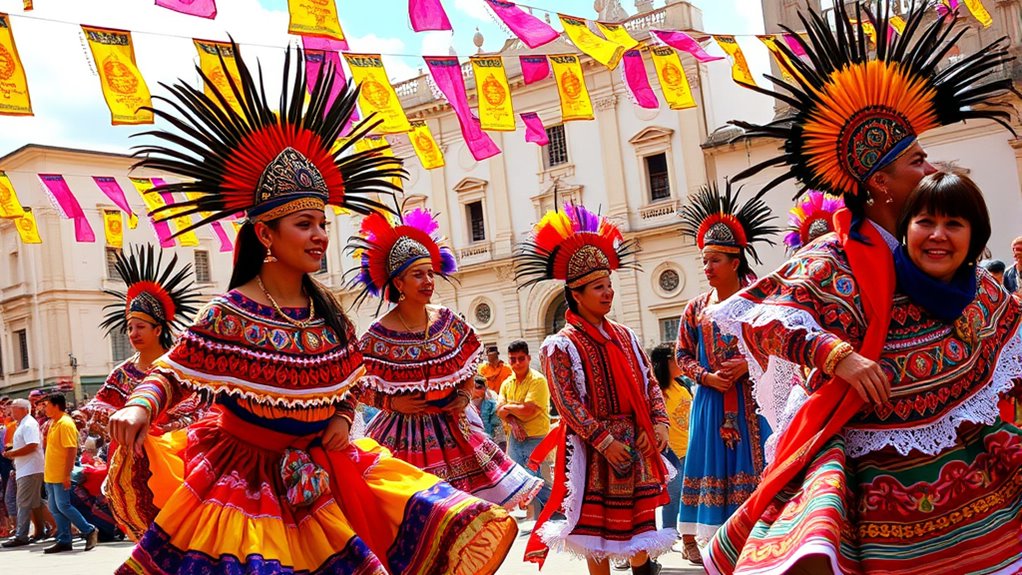
Contemporary Ecuadorian culture thrives through vibrant expressions and lively celebrations that reflect its diverse heritage. You’ll find festivals like the Fiestas de Quito, where traditions come alive with colorful parades, music, and dance. Indigenous communities preserve their customs through ceremonies and crafts, showcasing intricate textiles and pottery. Modern artists blend traditional motifs with contemporary styles, creating dynamic visual arts. Food plays a central role, with celebrations featuring dishes like ceviche and hornado that highlight regional flavors. You can also experience the lively atmosphere during Carnival, with water fights and music filling the streets. Environmental awareness influences many events, emphasizing conservation and sustainability. These celebrations and expressions demonstrate how Ecuador’s rich history continues to inspire its vibrant present, with cultural preservation playing a key role in maintaining the nation’s identity.
Frequently Asked Questions
How Have Indigenous Traditions Influenced Modern Ecuadorian Cuisine?
You can see indigenous traditions influence modern Ecuadorian cuisine through dishes like llapingachos, a potato pancake, and ceviche, made with fresh local ingredients. Traditional ingredients such as corn, potatoes, and plantains remain staples, while indigenous cooking techniques like slow roasting and fermentation still shape how dishes are prepared. You’ll notice vibrant flavors and regional variations that reflect Ecuador’s diverse indigenous heritage, blending ancient practices with contemporary culinary styles.
What Role Did Women Play During Ecuador’s Independence Movement?
Women were the silent architects of Ecuador’s independence, their courage fueling the flames of rebellion. You see, they organized gatherings, smuggled weapons, and provided crucial support to fighters, often risking their lives. Their resilience, like a steadfast river carving through mountains, shaped the movement’s course. Women’s sacrifices and leadership, though sometimes unrecognized, proved essential, proving that even in silence, their voices echoed loudly in the fight for freedom.
How Does Ecuador Integrate Traditional and Contemporary Art Forms Today?
You see Ecuador integrates traditional and contemporary art through vibrant festivals, galleries, and public art projects. You can explore indigenous motifs blended with modern styles in paintings, textiles, and sculptures. Artists often incorporate traditional techniques into new media, creating dynamic pieces that celebrate cultural heritage while embracing innovation. You’ll find this fusion reflected in museums, street art, and cultural events, showcasing Ecuador’s rich artistic diversity and evolving creative spirit.
What Are the Most Significant Archaeological Discoveries in Ecuador?
You discover Ecuador’s most significant archaeological sites like Cochasquí and Cuello de Luna, revealing its rich past. These sites showcase ancient mounds, artifacts, and petroglyphs, offering insights into pre-Inca civilizations and the Inca Empire. They connect you to a history of sophisticated agriculture, cultural diversity, and ancient innovation. Exploring these discoveries, you witness Ecuador’s deep-rooted heritage, bridging the ancient and modern while inspiring a profound appreciation for its archaeological treasures.
How Has Ecuador’s Environmental Diversity Shaped Its Cultural Identity?
You see Ecuador’s environmental diversity shaping its cultural identity through its vibrant traditions, festivals, and daily life. You’re likely to notice how indigenous practices blend with modern customs, reflecting the rich natural landscape—from the Amazon rainforest to the Andean mountains and Galápagos Islands. This diversity inspires unique art, cuisine, and spiritual beliefs, fostering a deep connection to nature that’s woven into the very fabric of Ecuadorian culture.
Conclusion
You witness Ecuador’s rich history, where ancient indigenous traditions meet colonial influences, shaping a vibrant culture. Despite struggles for independence, the nation’s spirit remains resilient, balancing progress with deep-rooted heritage. Today, modern innovations flourish alongside traditional celebrations, proving that change and tradition can coexist. In Ecuador, the past and present intertwine, reminding you that a nation’s identity is built on both its struggles and its celebrations—an ongoing dance between history and hope.

